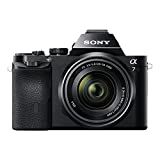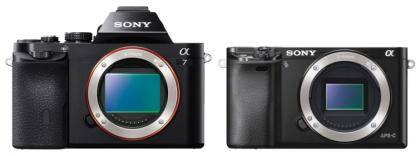Sony Alpha a7 review: DSLR-beating quality in a pint-sized package
Technical innovation doesn't always produce products people actually want to buy, but Sony's digital cameras have been delivering the goods on both fronts recently. We're tempted to say that the a7 is its greatest achievement to date.
Sony Alpha a7 review: What you need to know
At first glance it looks like a typical upmarket compact system camera (CSC). The SLR-like design with its angular viewfinder hump is a departure from previous NEX models (now going by the Alpha brand), and resembles the Olympus OM-D range . However, the big change is on the inside. While it uses the same E-Mount lenses as previous Sony CSCs, this is one of the first CSCs (along with the 36-megapixel a7R) to use a full-frame sensor.
It's an important milestone in CSCs' ability to challenge SLRs' dominance among photography enthusiasts. It's also an extraordinary technical achievement. One of the reasons why CSCs are smaller than SLRs is that they dispense with the lens mounts that were originally designed for full-frame cameras. The a7's sensor barely fits behind its lens mount – the incoming light must be turning some tight corners inside the lens to cover the entire frame. The result is a full-frame interchangeable-lens camera that weighs 474g, or 769g with its 28-70mm kit lens. That's a little over half the weight of a Nikon D610 or Canon EOS 6D with their kit zoom lenses.


Sony Alpha a7 review: Lens options
The a7 will accept any E-Mount lens, but to shoot full frame it must be paired with one of the new FE models. There are currently five available. The FE 28-70mm F3.5-5.6 OSS is available with the a7 as a kit for around £1,500, or separately for £450. Alternatively, there's the more upmarket FE 24-70mm f4 ZA OSS Carl Zeiss Sonnar T*, available for £1,050. Two primes are available: a 35mm f/2.8 for £750 and a 55mm f/1.8 for £930. The FE 70-200mm F4 G OSS telephoto lens is available to pre-order from Sony for £1,239.

It's a very big sensor in a very compact body, here in comparison to an APS-C based Alpha
While the a7's price is remarkably low for a full-frame camera, these lenses are expensive considering their specifications. Sony sent us the 55mm f/1.8 for testing, which isn't far off the specs of 50mm f/1.8 lens available for SLRs for around £100. However, the optical performance of this 55mm lens is in a different league to those cheap SLR lenses, with extremely sharp details even when shooting wide open at f/1.8. If the other lenses in the FE range are anything like this one, their prices start to seem a lot more reasonable.
We accidentally took this photo at f/1.8 – something around f/8 would have probably been more appropriate to ensure the sharpest possible details. However, it's really hard to fault the level of fine detail here
Sony a7 review: Features and handling
Sony has cut the size and weight but it hasn't cut down on features. The 3in LCD screen tilts up and down, and the viewfinder is the same large XGA OLED display that we've been so impressed by on various other Sony cameras. The handgrip is much smaller than SLRs' grips, but it's nicely contoured and the a7 feels secure when held in one hand. The card slot is on the side rather than in the battery compartment, so it's still accessible when shooting with a tripod.
There are dual command dials, a mode dial and exposure compensation dial neatly arranged on the top plate, plus a wheel on the back. In manual exposure mode, the command dials handle shutter speed and aperture while the rear wheel looks after the ISO speed. Leave the ISO speed on Auto and the exposure remains automatic for a shutter-and-aperture-priority mode, complete with exposure compensation. This is perfect for carefully controlling depth of field and motion blur without having to worry about the overall exposure level.
In fact, we found ourselves using this method routinely, as the fully automatic settings are less than ideal. Testing with the 55mm f/1.8 lens, the aperture seemed to be stuck at f/4 in low light, resulting in needlessly high ISO speeds. It was only when the ISO speed reached 6400 that wider apertures were used. There's no way to customise the behaviour of the Auto ISO function. Another snag is that the rear wheel is easy to nudge by accident. We got around this by disabling the wheel's default function and assigning ISO speed to the C3 button, which is unassigned by default.
There are three customisable buttons, plus a button and associated switch that toggles between two labelled functions: AF/MF and AEL. In fact, all five can be customised to any of 46 functions, and so too can the five buttons on the navigation pad. The C1 button on the top plate is assigned to Autofocus Settings by default, whereby the rear wheel cycles through the various multi, zone, centre and spot options, while the dual command dials adjust the position vertically and horizontally. It's a good system that works well with both the viewfinder and LCD screen, but we'd have preferred a touchscreen for the fastest possible autofocus area adjustment.
We're particularly excited to see an option called Eye AF, which is assigned to the centre of the navigation pad by default. It uses face detection to focus on a subject's eye – perfect for a full-frame camera where the depth of field can be extremely shallow. There's also an AF-On function, which invokes the autofocus without taking a photo, plus an option to disable autofocus when the shutter release is pressed – thereby separating focusing and shooting into discrete buttons.
Wi-Fi and NFC are built in, with remote shooting and wireless transfer functions in conjunction with the PlayMemories apps for iOS and Android. It all works elegantly, but remote shooting control is limited to the shutter release, exposure compensation and self-timer function. It doesn't work as a remote monitor for video recording. The camera can download apps to add extra in-camera functions such as time-lapse shooting and photo retouching.
The app has limited controls, though exposure compensation is a welcome tweak
It seems there wasn't room to include an integrated flash, or at least, Sony chose not to do so. The Multi Interface Shoe accepts standard flashguns as well as various proprietary Sony peripherals, but we'd have liked a small clip-on flash to complement the camera's diminutive design. Battery life is another casualty of the small design. It's the same battery that's been used in NEX cameras for many years, but the higher demands of the full-frame sensor means it only lasts for 270 shots. Spares cost around £65, but managing multiple batteries is complicated by the fact that charging is in-camera. An external charger (part BC-TRW) can be picked up on eBay for around £50.
Sony Alpha a7 review: Video mode
The a7 is well specified as a video camera. It records in AVCHD format at 1080-25p, 50i or 50p, with clip lengths up to 30 minutes and bit rates to 28Mbit/s. The HDMI output can stream a clean video feed for recording to or monitoring on external devices. There are microphone and headphone sockets, with clear metering and quick access to the volume control via one of the customisable buttons. Priority and manual exposure modes are available for video, including aperture-and-shutter priority with automatic ISO speed and variable exposure compensation. Unlike Sony's SLT cameras, manual exposure and autofocus are available at the same time. However, the selected autofocus area appears to be ignored while recording. Most keen videographers will prefer to use manual focus anyway; this is well catered for with focus peaking to highlight parts of the scene that are in sharp focus.
With such a long list of strengths, video quality was disappointingly mixed. It excelled for low noise, with respectable results at ISO 6400 and the ability to shoot at up to ISO 25600. Details in well-lit conditions were far from poor but they weren't as crisp as from the Sony RX10 or Panasonic's Lumix G cameras. We also noticed some moiré interference that was absent in the same scene shot with a Panasonic G6 . These issues shouldn't dissuade photographers who also want to shoot a few videos, but we wouldn't recommend the a7 primarily for video work.
Sony Alpha a7 review: Image quality
There are no such hang-ups for photographers. Image quality lived up to expectations raised by the 24-megapixel full-frame sensor, with precise details and lower noise than almost every other CSC to date. Only Fujifilm's 16-megapixel X-Trans sensor, which appears in the Fujifilm X-M1 , Fujifilm X-T1 and Fujifilm X-E2, comes close to competing for noise levels.
As usual for Sony cameras, noise reduction is applied liberally to JPEGs. This gave decent results when resizing images down to modest resolutions but it took a heavy toll on fine details. Regardless, it's hard to imagine many full-frame camera owners who won't prefer to shoot RAW.
Details are crisp in this f/1.8 shot, and the full-frame sensor allows for a flattering shallow depth of field
Dense textures are handled reasonably well in this JPEG at ISO 100, although the grass looks a little flat. As usual, shooting RAW gives the best results
The automatic exposure is well-judged in this tricky scene with areas of light and shade, and focus is bang on
It's a treat to have dramatic depth-of-field effects from such a small, lightweight camera
Noise is barely perceptible in this ISO 2000 shot, although there is a slight plastic quality to details – a tell-tale sign of noise reduction
Shaded skin tones are still looking pretty good at ISO 6400. Lightroom does a better job with the RAW file
ISO 20,000, and still good enough for casual snaps
Sony Alpha a7 review: Performance
Photo performance was good rather than excellent. 2.2 seconds to switch on and shoot is slower than most CSCs, and 0.8 seconds between shots is a on the slow side, too. Autofocus was responsive, though, in most instances taking around 0.3 seconds to focus and shoot. It slowed to around a second in very low light, but very rarely failed to focus at all. Focusing errors were extremely rare, too. The main imaging sensor incorporates phase-detect autofocus points, and these can be switched on and off in the menu. Autofocus times seemed to be more consistent with it enabled but there wasn't a huge difference.
Continuous shooting came in at 4.8fps in our tests. There are much faster CSCs, but it's a respectable result compared to entry-level full-frame SLRs. Unlike on most CSCs, this top speed is available in conjunction with continuous autofocus for tracking moving subjects. It lasted for 59 JPEGs or 27 RAW frames before slowing to 1.6fps and 1.3fps respectively. Most controls are operational while shots are being saved to card, but not the main menu.
Sony Alpha a7 review: Verdict
There's no doubt about it – the a7 is an extraordinary camera. Full-frame quality in such a small, light and reasonably priced package is a stunning achievement, and a watershed moment for CSCs. There are other breakthroughs, too: Eye AF is something a conventional SLR could never do with its phase-detection autofocus system. We suspect that most professional and serious amateur photographers aren't ready to dump their SLRs in favour of a CSC, but the a7 might make them think twice.
It's far from perfect, though. The short battery life and lack of a dedicated charger are big setbacks for a small camera that's likely to be taken for long days out. Then there's the limited choice and high cost of compatible lenses. We loved shooting with the 55mm f/1.8, but there are no two ways about it - £930 is a huge amount to spend on a prime lens.
The a7 doesn't quite manage to supplant the Fujifilm X-T1 as our favourite premium CSC. The X-T1 comes top for ergonomics, it's in the same ball park for image quality and its brighter lenses help it achieve comparable depth-of-field effects and low noise levels. Its lenses are cheaper, too.
Then again, the a7 comes a very close second, and makes us wonder how other premium CSCs with their smaller sensors can hope to compete. It's not surprising that Sony was the company to deliver the first full-frame CSC. We're very glad it did.
Buy now from Amazon for £678.84
|
Basic Specifications |
|
Rating |
**** |
|
CCD effective megapixels |
24.0 megapixels |
|
CCD size |
35.8x23.9mm |
|
Viewfinder |
electronic, 2.4 megapixels |
|
Viewfinder magnification, coverage |
0.71x, 100% |
|
LCD screen size |
3.0in |
|
LCD screen resolution |
921,600 pixels |
|
Articulated screen |
Yes |
|
Live view |
Yes |
|
Optical zoom |
N/A |
|
Zoom 35mm equivalent |
N/A |
|
Image stabilisation |
Available in lenses |
|
Maximum image resolution |
6,000x4,000 |
|
File formats |
JPEG, RAW; AVCHD, MP4 (AVC) |
|
Physical |
|
Memory slot |
SDXC, Memory Stick Pro HG Duo |
|
Mermory supplied |
none |
|
Battery type |
Li-ion |
|
Battery Life (tested) |
270 shots |
|
Connectivity |
USB, micro HDMI, microphone in, headphone out, Wi-Fi, NFC |
|
Body material |
magnesium alloy, plastic |
|
Lens mount |
Sony E mount |
|
Focal length multiplier |
1.0x |
|
Kit lens model name |
N/A |
|
Accessories |
USB cable, neck strap |
|
Weight |
474g |
|
Size |
95x128x59mm |
|
Buying Information |
|
Warranty |
one year RTB |
|
Price |
£1,235 |
|
Supplier |
http://www.wexphotographic.com |
|
Details |
www.sony.co.uk |
|
Camera Controls |
|
Exposure modes |
program, shutter priority, aperture priority, manual |
|
Shutter speed |
30 to 1/8,000 seconds |
|
Aperture range |
N/A |
|
ISO range (at full resolution) |
50 to 25600 |
|
Exposure compensation |
+/-3 EV |
|
White balance |
auto, 10 presets with fine tuning, manual, Kelvin |
|
Additional image controls |
contrast, saturation, sharpness, noise reduction, dynamic range optimisation, soft skin effect, colour space |
|
Manual focus |
Yes |
|
Closest macro focus |
N/A |
|
Auto-focus modes |
multi, zone, centre, flexible spot, face detect, eye detect |
|
Metering modes |
multi, centre-weighted, centre, face detect |
|
Flash |
N/A |
|
Drive modes |
single, continuous, self-timer, AE bracket, WB bracket, dynamic range bracket, smile detect, panorama, HDR |
Basic Specifications
Physical
Buying Information
Camera Controls
